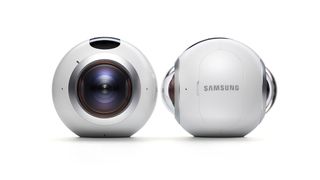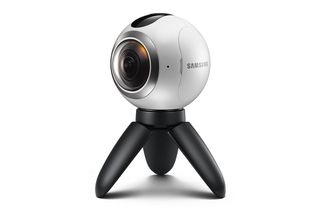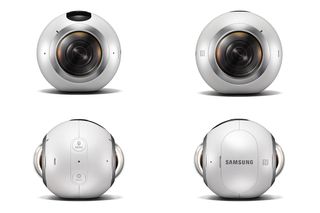Samsung's Gear 360 VR Camera Designed To Work With Galaxy S7, S7 Edge

In late 2014, Samsung announced its first 360-degree camera, dubbed Project Beyond. This is a professional-level "3d omniview" stereoscopic camera with 17 cameras and UHD 3D capture, designed to film the highest quality 360-videos possible. After fading from public view for a while, Project Beyond resurfaced at CES this year, and at around the same time Samsung filed a patent for a "Gear 360" product, leading people to speculate that it would be the go-to-market name for the project.
This week at MWC 2016, Samsung cleared up all the confusion and announced the Gear 360, a monoscopic 360-degree consumer video camera designed to be used with the new Galaxy S7 and S7 edge phones. This means that pricing and availability for Project Beyond is still to be announced, but likely to be in the five-figure price range, whereas the Gear 360 will be sold at a much more consumer-friendly three-figure price (though pricing was not disclosed yet).

To be honest, comparing the two cameras is pointless because the Gear 360 is designed to make shooting 360-video accessible to the masses, whereas the Beyond is for professional filmmakers. The Gear 360 has a light (153g) and compact spherical design, and looks like a high-tech eyeball (or a Portal Sentry Turret when it's on its stand). It is also splash proof and dust resistant and comes with a small tripod. It also uses an industry-standard thread size, so it can be mounted using a wide variety of camera mounts for more versatility.
The Gear 360 is targeting the same market as the LG 360 CAM also announced at MWC, but its specs are a bit more on the higher-end. It has two 15MP cameras that produce a 30MP spherical image when stitched and it can capture 3840 x 1920, 360-degree video (the LG has two 13MP cameras and can capture up to 2K 360-degree video). The Gear 360 also has a wide aperture f/2.0 lens for better low-light performance. You can see a sample video shot with the Gear 360 above (remember to pan around with your mouse or by tilting your phone if not viewing in VR).
Specifications
| Camera | Two CMOS 15MP fisheye cameras |
|---|---|
| Image Processor | DRIMe5s |
| Video | MP4 (H.265) - Dual Lens: 3840x1920 (30fps) |
| Still Image | JPEG - Dual Lens: 30M (7776x3888) |
| Audio | Codec: MP3/AAC/AAC+/eAAC+Format: MP3, M4A, AAC, OGG |
| Memory | microSD card (Up to 128GB) |
| Features | Display: 0.5" (72 x 32) PMOLEDShooting mode: Video, Photo, Time Lapse Video, Looping VideoCamera mode: Dual/Single Lens modeCamera Setting: Sharpness, White Balance, HDR, EV, ISO limit, Wind cutIP53 Certified Dust and Water Resistant |
| Samsung Services | Samsung Gear 360 App, PC S/W (Gear 360 Action Director) |
| Connectivity | WiFi 802.11 a/b/g/n/ac (2.4/5GHz), WiFi Direct,BlueTooth v4.1, USB 2.0, NFC |
| Sensors | Accelerometer, Gyroscope |
| Dimension & Weight | 66.7 x 56.2 x 60 mm, 153g (including battery) |
| Battery | 1,350mAh Li-ion |
The Gear 360 connects to "select Samsung smartphones," including the S7 and S7 edge. Let's hope it can be used with Samsung's 2015 flagship devices too. When connected to a phone, you can preview what the camera is shooting in real time and control the camera with it. You can save the footage the Gear 360 captures to its microSD card, or to your smartphone to share it directly with social media, though Samsung didn't specify which channels it will support.

You can also livestream 360-video from the camera, with the footage from the two cameras stitched together by the Samsung Gear 360 App on your phone. Footage captured with the Gear 360 can either be viewed in 2D using the Gear 360 app, or in VR using the Gear VR.
Like so many MWC announcements, pricing and availability (beyond a vague "Q2 2016 in select countries") was not disclosed by Samsung.
Stay on the Cutting Edge
Join the experts who read Tom's Hardware for the inside track on enthusiast PC tech news — and have for over 25 years. We'll send breaking news and in-depth reviews of CPUs, GPUs, AI, maker hardware and more straight to your inbox.
Most Popular



